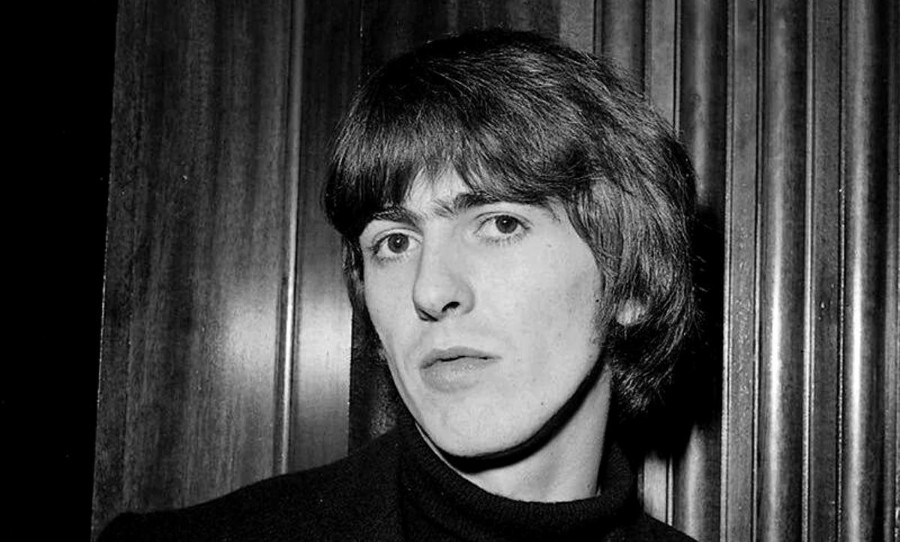Solid State: The Story of Abbey Road and the End of the Beatles is a new book by acclaimed Beatles historian Kenneth Womack, focused on the myths and legends behind the recording of Abbey Road.
The following extract from the book describes George Harrison’s budding involvement with The Beatles as a key songwriter; and how after a few false starts he would cement this role with Here Comes The Sun. Enjoy.

Learn how Here Comes The Sun came to be in this exclusive extract from Kenneth Womack’s Solid State: The Story of Abbey Road and the End of the Beatles.
When George Harrison unveiled his latest composition, “Here Comes the Sun,” it was much to the delight of his bandmates. With songs like The White Album’s “While My Guitar Gently Weeps,” and, more recently, “Something,” Harrison had finally proven his mettle as a songwriter of the highest order. For Lennon, “Something” had been a revelation. As he later recalled, “Paul and I really carved up the empire between us, because we were the singers. George didn’t even used to sing when we brought him into the group. He was a guitarist. And for the first few years he didn’t sing on stage. We maybe let him do one number, like we would with Ringo.” By the time Harrison started his life as a working songwriter, “there was an embarrassing period where his songs weren’t that good,” Lennon added, “and nobody wanted to say anything, but we all worked on them—like we did on Ringo’s. I mean, we put more work into those songs than we did on some of our stuff. So he just wasn’t in the same league for a long time—that’s not putting him down; he just hadn’t had the practice as a writer that we’d had.”
There is little doubt that Harrison acutely recognised his middling place in the Beatles’ songwriting pecking order, yet he remained undeterred in his resolve to go toe-to-toe with the composers behind “She Loves You,” “I Want to Hold Your Hand,” “In My Life,” “Eleanor Rigby,” and countless other gems in the twentieth-century songbook. “I wasn’t Lennon, or I wasn’t McCartney,” he remarked, “I was me. And the only reason I started to write songs was because I thought, ‘Well, if they can write them, I can write them.’” As recently as the spring months of 1967, he endured the dispiriting experience of having one of his composition, “Only a Northern Song,” rejected by Martin, who felt that it wasn’t up to snuff for inclusion on Sgt. Pepper. In a moment of great triumph, Harrison returned with a vengeance, recording the superior “Within You, Without You” for Sgt. Pepper. With “Here Comes the Sun,” Harrison would succeed in elevating his status yet again. During the January 1969 Get Back sessions, he observed Lennon plying away on “Sun King,” a new composition that featured the lyrics “here comes the sun.” That April, Harrison deployed that germ of an idea in fine style as he strolled around the garden at Hurtwood Edge, Eric Clapton’s country estate. Years later, Clapton would fondly remember the experience of observing his friend’s creative energy in full bloom. “It was a beautiful spring morning, and we were sitting at the top of a big field at the bottom of the garden,” he recalled. “We had our guitars and were just strumming away when he started singing ‘de da de de, it’s been a long cold lonely winter,’ and bit by bit he fleshed it out, until it was time for lunch.”
As with such recent McCartney compositions as “You Never Give Me Your Money” and “Carry That Weight,” Harrison’s “Here Comes the Sun” demonstrated that McCartney hadn’t been the only Beatle plagued by the band’s recent fiscal crises: “‘Here Comes the Sun’ was written at the time when Apple was getting like school, where we had to go and be businessmen: ‘Sign this’ and ‘sign that,’” Harrison later recalled. “Anyway, it seems as if winter in England goes on forever, by the time spring comes you really deserve it. So one day I decided I was going to sag off Apple and I went over to Eric Clapton’s house. The relief of not having to go see all those dopey accountants was wonderful, and I walked around the garden with one of Eric’s acoustic guitars and wrote ‘Here Comes the Sun.’”
Harrison completed the song during his May vacation with wife Pattie in Sardinia, putting the finishing touches on the lyrics, which he had scrawled on his personal stationery, replete with a Hindu drawing and spiritual quotations. In order to provide a mnemonic device to remind him of his scat lyrics, he described his refrain as “scoobie doobie,” while referring to his guitar part during the bridge as “son of ‘Badge,’” in reference to the descending guitar figure in his Cream composition with Clapton. Harrison illustrated his lyrics with a sketch of a smiling, radiant sun. With engineers Phil McDonald and John Kurlander joining him up in the booth, Martin commenced the session for “Here Comes the Sun” on the afternoon of July 7th. The genial atmosphere that day was in vogue from start to finish. When the first take resulted in a false start, Harrison playfully remarked, “One of me best beginnings that!” As it happened, “Here Comes the Sun” was deceptively easy, shifting across a complexity of different time signatures in quick session, including 4/4 time during the verses, punctuated by an intricate 11/8 + 15/8 sequence. For the recording, the bandmates concocted a basic rhythm track that featured Harrison singing a guide vocal and playing the song’s distinctive melody on his Gibson J-200 acoustic guitar, McCartney on bass, and Starr—who was celebrating his 29th birthday—on the drums. After Martin and the Beatles selected take 13 as the best of the lot, Harrison devoted the remainder of the session to refining his guitar part even further. With his capo on the 7th fret, Harrison brought the basic track for “Here Comes the Sun” to fruition, perfecting the song’s gentle acoustic introduction in the process.
For his part, Martin was excited by the evolution of Harrison’s latest composition. “I think there was a great deal of invention,” Martin later recalled. “I mean, George’s ‘Here Comes the Sun’ was the first time he’d really come through with a brilliant composition, and musical ideas, you know, the multiple odd rhythms that came through. They really became commercial for the first time on that one.”
Solid State: The Story of Abbey Road and the End of the Beatles is out now via Cornell University Press.



